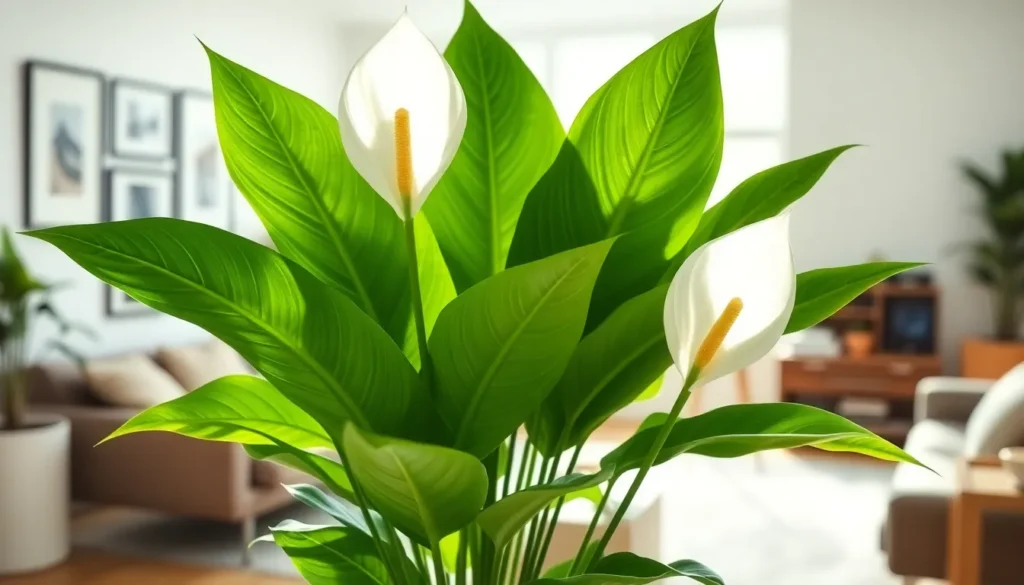Peace lilies have captured our hearts as one of the most beloved houseplants worldwide – and for good reason. These elegant beauties don’t just bring stunning white blooms and lush green foliage to our homes; they’re also incredibly forgiving and long-lasting companions that can thrive for years with proper care.
We’ve all wondered how long our cherished peace lily will grace our living spaces with its presence. The answer might surprise you – these resilient plants can live anywhere from 5 to 10 years indoors, with some exceptional specimens reaching even greater ages when they receive optimal care and attention.
Understanding your peace lily’s lifespan isn’t just about curiosity; it’s about maximizing the joy and air-purifying benefits these plants bring to our homes. Whether you’re a seasoned plant parent or just starting your green journey, knowing what influences your peace lily’s longevity will help you create the perfect environment for years of beautiful blooms and healthy growth.
Understanding Peace Lily Lifespan Basics
Peace lily lifespan basics form the foundation for maintaining these elegant houseplants successfully over many years.
Average Lifespan Expectations
Peace lilies typically live 5 to 10 years when grown as indoor houseplants under standard home conditions. Outdoor peace lilies in tropical climates can survive 15 to 20 years or longer due to optimal growing conditions.
Indoor peace lily longevity varies based on care quality and environmental stability. Well maintained specimens often reach the upper end of this range, while neglected plants may decline within 3 to 4 years.
| Environment | Average Lifespan | Maximum Lifespan |
|---|---|---|
| Indoor houseplant | 5-10 years | 12-15 years |
| Outdoor tropical | 15-20 years | 25+ years |
| Greenhouse conditions | 10-15 years | 20+ years |
Factors That Influence Longevity
Light exposure directly affects peace lily health and longevity since these plants require bright, indirect sunlight for photosynthesis and energy production. Direct sunlight burns the leaves while insufficient light weakens the plant’s immune system.
Watering consistency determines root health and overall plant vitality throughout the peace lily’s lifetime. Overwatering causes root rot within 2 to 3 weeks, while underwatering stresses the plant and reduces flowering capacity.
Humidity levels impact leaf health and pest resistance since peace lilies originate from tropical rainforest environments with 40% to 60% humidity. Low humidity below 30% causes brown leaf tips and increases susceptibility to spider mites.
Temperature stability affects cellular processes and growth patterns because peace lilies thrive in temperatures between 65°F and 80°F. Temperature fluctuations below 60°F or above 85°F stress the plant and accelerate aging.
Fertilization frequency influences nutrient availability and bloom production since peace lilies require balanced feeding every 6 to 8 weeks during growing season. Overfertilization burns roots while nutrient deficiency weakens the plant’s natural defenses.
Repotting timing determines root space and soil quality refresh cycles because peace lilies become rootbound every 2 to 3 years. Delayed repotting restricts growth while premature repotting shocks the root system.
Materials and Tools Needed for Long-Term Care
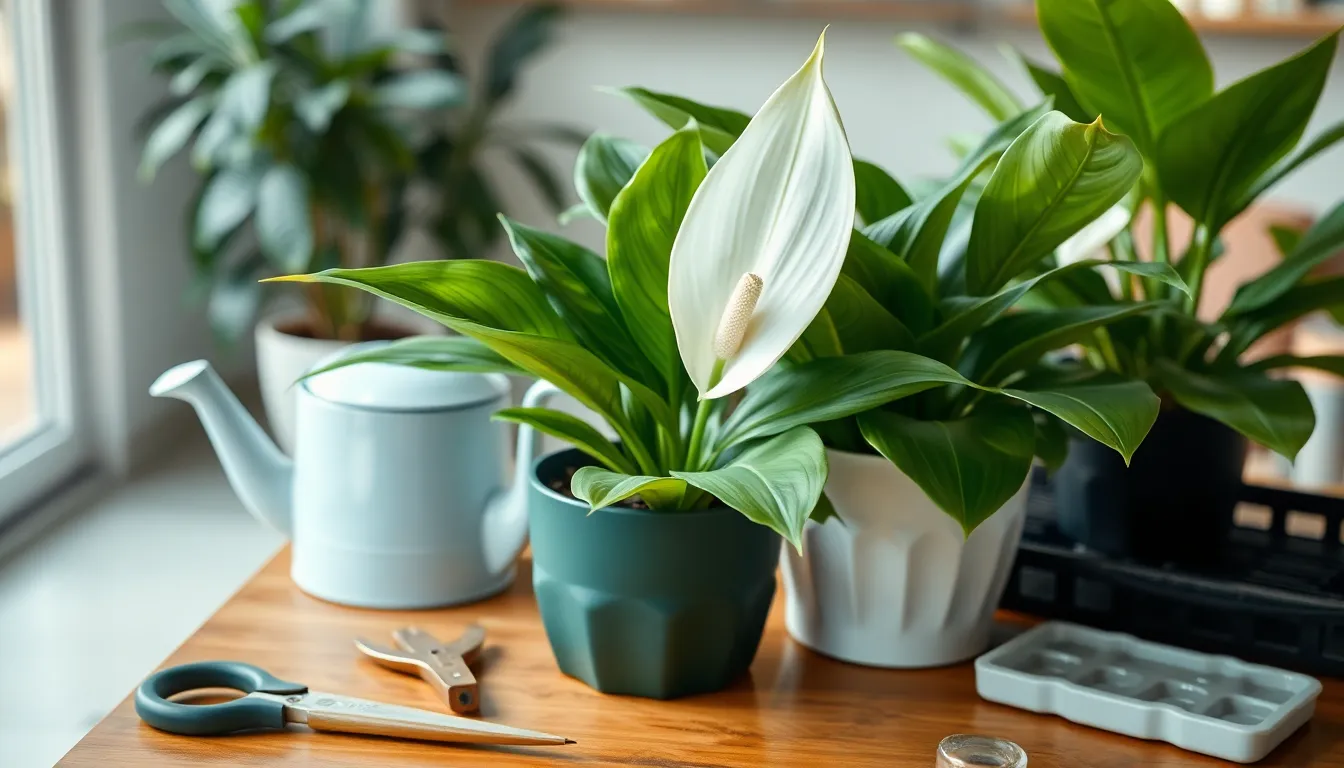
Quality potting soil forms the foundation for extending your peace lily’s 3 to 5 year typical lifespan into the decade range that optimal care can achieve. We recommend using well-draining potting mixes that contain peat moss or coconut coir to maintain the moisture balance these plants require.
Balanced liquid fertilizer with equal nitrogen, phosphorus, and potassium ratios supports healthy growth without causing nutrient burn. Dilute the fertilizer to quarter strength and apply monthly during growing seasons to maintain the nutrient levels that promote longevity.
Watering equipment includes a long-spout watering can or moisture meter to prevent the overwatering that leads to root rot. These tools help us deliver consistent hydration while avoiding the waterlogged conditions that reduce peace lily lifespans.
Clean pruning shears remove dead or yellowing leaves that can harbor pests and diseases. Sharp, sterilized tools make clean cuts that heal quickly and prevent bacterial infections from shortening your plant’s life.
Appropriate sized pots with drainage holes accommodate root growth as your peace lily matures. We suggest choosing containers 1 to 2 inches larger in diameter than the current pot when repotting every 2 to 3 years.
Humidifier or humidity tray maintains the high moisture levels that peace lilies prefer indoors. These devices create the 40 to 60 percent humidity range that supports healthy foliage and extends plant longevity beyond average indoor conditions.
Insecticidal soap or neem oil treats common pests like spider mites and aphids before they damage your peace lily. Early intervention with these organic treatments prevents the stress that can significantly reduce your plant’s lifespan from the typical 3 to 5 years.
Creating Optimal Growing Conditions

Peace lilies thrive in environments that mirror their native tropical habitats. Balanced care across all growth factors extends their indoor lifespan from the typical 5 to 10 years to potentially longer periods.
Light Requirements for Maximum Lifespan
Bright, indirect light provides the optimal lighting conditions for peace lily longevity. Direct sunlight causes leaf scorch and reduces the plant’s overall lifespan by damaging delicate foliage tissues.
East-facing windows deliver ideal light exposure throughout the day. These locations offer gentle morning sunlight followed by filtered light that prevents heat stress. North-facing windows also work well for consistent, indirect illumination.
Avoid placing peace lilies in south or west-facing windows where intense afternoon sun creates harsh conditions. Low light environments reduce flowering frequency and weaken plant vigor over time.
Temperature and Humidity Control
Consistent temperatures between 65°F to 80°F maintain optimal peace lily health throughout their lifespan. Temperature fluctuations stress the plant and accelerate aging processes.
Keep peace lilies away from heating vents, air conditioning units, and drafty windows. These locations create temperature variations that compromise long-term plant stability.
High humidity levels replicate the tropical conditions peace lilies require for maximum longevity. Misting leaves regularly increases ambient moisture around the plant. Humidifiers provide consistent humidity control in dry indoor environments.
Humidity trays filled with water and pebbles create localized moisture zones. Place the pot on top of the pebbles without touching the water to prevent root rot.
Soil and Potting Considerations
Rich, organic potting mix that retains moisture while draining excess water supports healthy root development. Peace lilies prefer slightly moist soil conditions without waterlogged roots.
Standard potting soil mixed with peat moss or coconut coir improves moisture retention. Adding perlite enhances drainage and prevents soil compaction over time.
Repot annually or when roots become visible outside drainage holes to maintain healthy growth. Spring timing allows plants to establish in fresh soil during active growing seasons.
Peace lilies prefer being slightly root-bound rather than having excessive space. Choose pots only 1 to 2 inches larger in diameter than the previous container to prevent overwatering issues.
Proper Watering Techniques to Extend Life
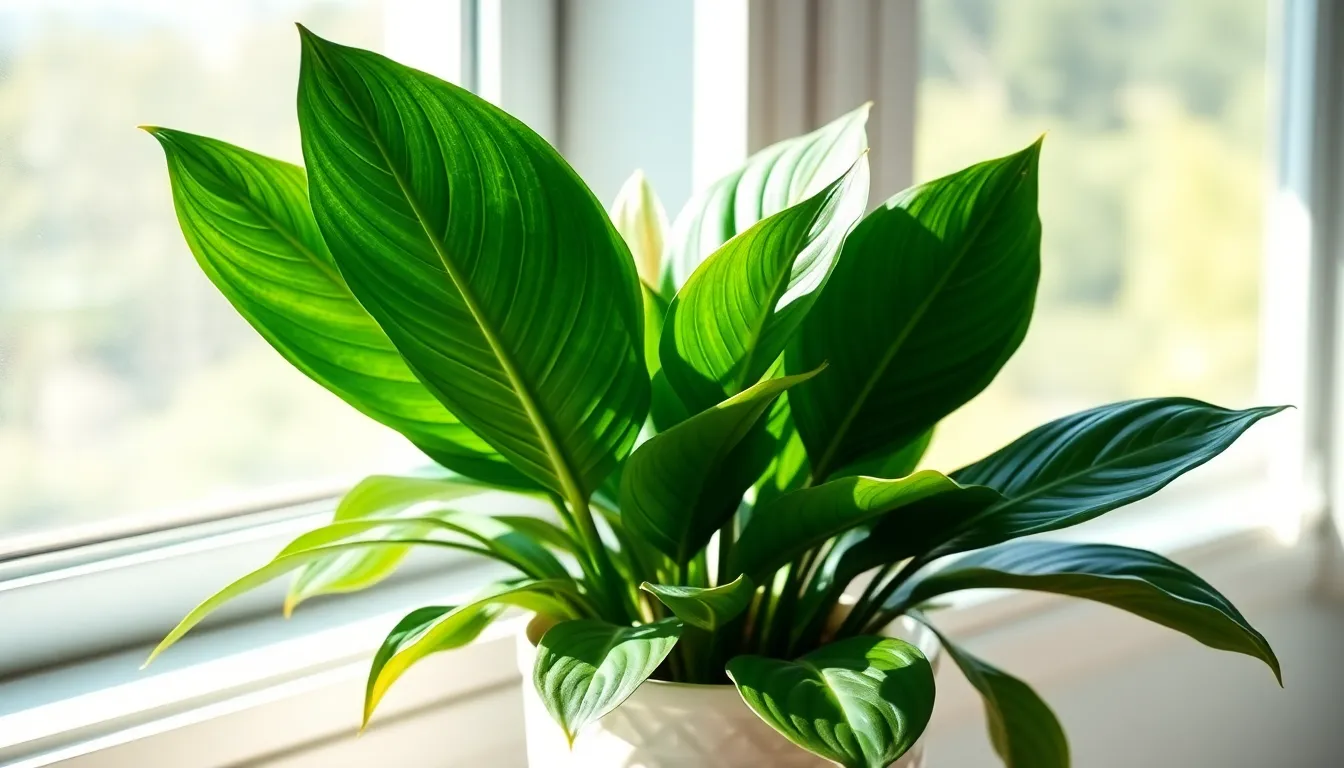
Watering practices directly impact peace lily lifespan and determine whether plants thrive for their full 5 to 10 year potential. Bottom watering prevents moisture from reaching leaves and eliminates black spot formation that can stress plants and reduce longevity.
Allow the top inch of soil to dry out before watering to maintain proper moisture balance. Testing soil moisture at this depth prevents both overwatering and underwatering conditions that shorten plant life. Reduce watering frequency during winter months when peace lilies require less moisture due to slower growth rates.
Signs of Proper Hydration
Glossy leaf appearance indicates optimal hydration levels in peace lilies. Healthy plants display vibrant green foliage with natural shine and firm texture throughout their leaves.
Dry soil surface extending one inch deep signals the correct watering timing. Checking moisture at this exact depth ensures roots receive adequate water without creating soggy conditions. Properly hydrated peace lilies maintain upright stems and leaves that resist wilting during normal indoor temperatures.
Leaf positioning remains stable when hydration levels stay consistent. Plants receiving appropriate moisture maintain their natural growth patterns without drooping or curling leaves.
Avoiding Overwatering and Underwatering
Overwatering causes root rot that kills peace lilies by preventing oxygen from reaching root systems. Consistently wet soil creates anaerobic conditions where harmful bacteria and fungi multiply rapidly.
Underwatering stresses plants and reduces their natural lifespan by forcing them to conserve energy instead of growing. Completely dry soil causes cellular damage that weakens plant structure over time.
Yellowing leaves indicate excessive moisture while wilted foliage signals insufficient water. Monitoring these visual cues helps maintain the precise moisture balance peace lilies require for maximum longevity.
Soil drainage plays a critical role in preventing water accumulation. Plants growing in containers without proper drainage holes experience waterlogged conditions that damage root systems and shorten overall lifespan.
Fertilizing for Longevity
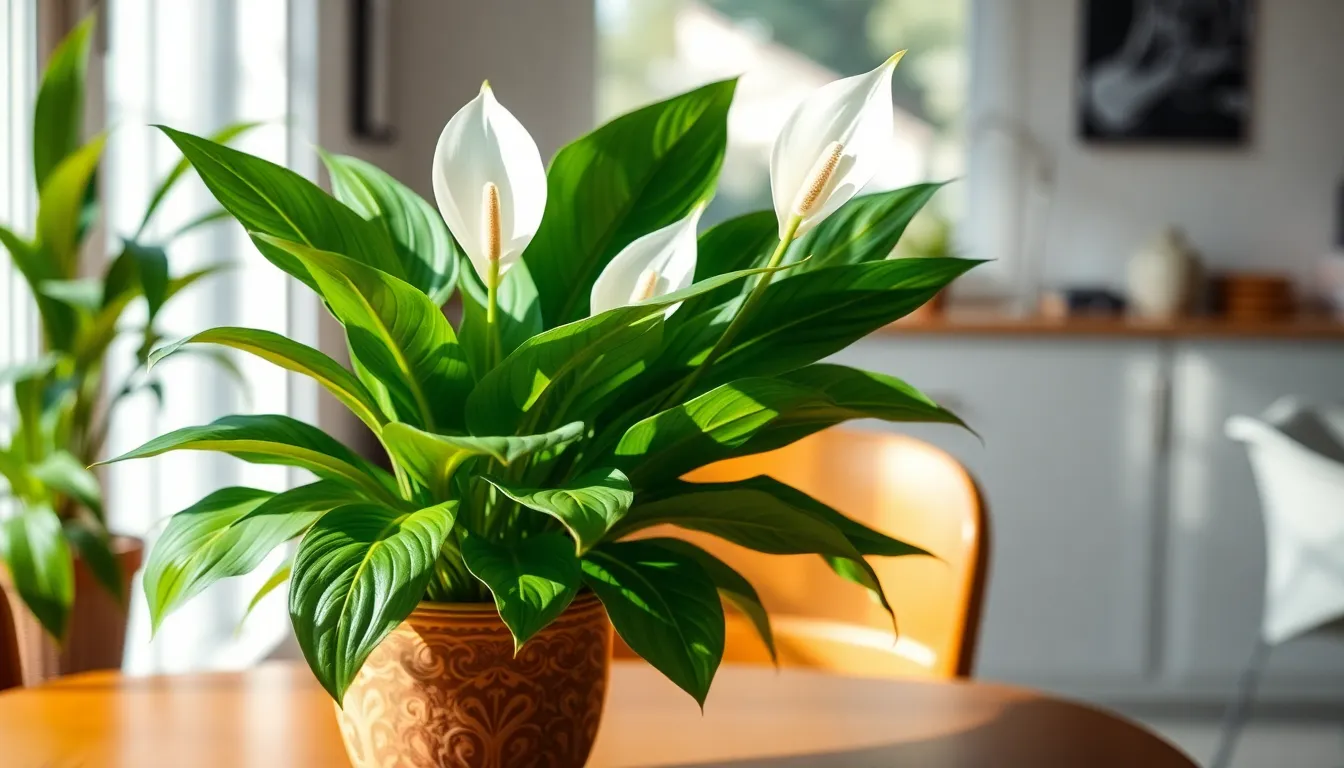
Balanced fertilization extends peace lily lifespan by providing essential nutrients without overwhelming the root system. Peace lilies thrive with moderate feeding that supports consistent growth and flowering over their 5 to 10 year indoor lifespan.
Best Fertilizer Types and Schedule
Water-soluble balanced fertilizers work optimally for peace lily nutrition since these plants function as light feeders rather than heavy nutrient consumers. Half-diluted fertilizer concentrations prevent root burn while delivering adequate nutrition for sustained growth.
Every six weeks during growing season represents the ideal fertilization frequency for maintaining peace lily health. This schedule provides consistent nutrition throughout late winter, early spring, and summer months when the plant demonstrates active growth patterns.
Liquid fertilizers dissolve completely in water and distribute nutrients evenly throughout the soil mixture. Granular fertilizers can create nutrient hot spots that damage sensitive peace lily roots. Balanced N-P-K ratios such as 10-10-10 or 20-20-20 support both foliage development and flowering capacity.
Half-strength dilution protects peace lily roots from fertilizer burn while maintaining adequate nutrient availability. Full-strength fertilizers overwhelm these moderate feeders and can reduce their overall lifespan through root damage.
Seasonal Feeding Adjustments
Spring and summer months require active fertilization since peace lilies demonstrate peak growth during these warmer seasons. Fertilize every six weeks from late winter through summer to support healthy foliage and encourage consistent flowering.
Autumn and winter periods call for reduced or eliminated fertilization as peace lilies enter dormancy phases. Plant metabolism slows significantly during cooler months, reducing nutrient requirements and making excess fertilizer potentially harmful to root systems.
Growth hormones naturally decrease during shorter daylight periods, making winter fertilization unnecessary and potentially damaging. Dormant plants cannot process excess nutrients effectively, leading to salt buildup in soil that stresses root systems and shortens overall plant lifespan.
Resume regular fertilization schedules when new growth appears in late winter or early spring. Fresh leaf emergence signals renewed metabolic activity and increased nutrient demands that support extended peace lily longevity.
Pruning and Maintenance Practices
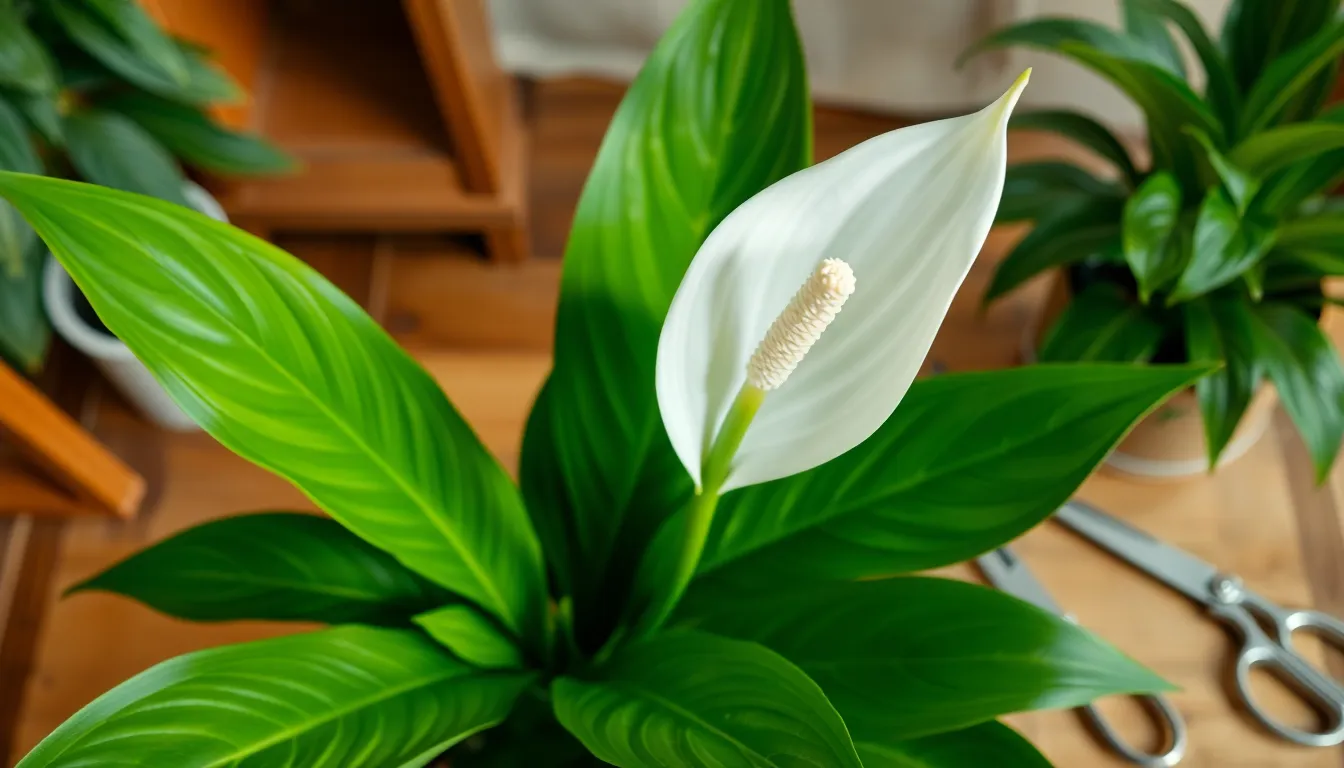
Regular maintenance keeps our peace lilies healthy and extends their 5 to 10-year indoor lifespan. Consistent pruning practices prevent energy waste and encourage vigorous new growth throughout the plant’s life cycle.
Deadheading Spent Blooms
Cut flower stalks at the base once blooms begin fading and turning brown to redirect the plant’s energy toward future flowering. This deadheading practice encourages our peace lilies to focus resources on new growth rather than seed production. Sharp, clean scissors make precise cuts that heal quickly and reduce infection risk. Regular deadheading throughout the blooming season maintains the plant’s appearance and promotes continuous flowering cycles.
Removing Yellow or Damaged Leaves
Trim yellow or damaged leaves immediately using clean, sharp scissors or pruners to cut each leaf at its base. Early removal prevents the plant from wasting energy on declining foliage and maintains overall plant health. Clean cutting tools between each cut to avoid spreading potential diseases to healthy plant tissue. Yellow leaves naturally occur as part of the aging process, but prompt removal keeps our peace lilies looking vibrant and directs nutrients to healthy growth.
When and How to Divide Plants
Divide rootbound peace lilies every 1 to 2 years during spring when new growth begins to appear. Gently remove the entire plant from its container and separate root clumps into smaller divisions, ensuring each section contains healthy roots and several leaves. Fresh, well-draining soil in appropriately sized pots supports each new division’s establishment and growth. Division not only revitalizes overcrowded plants but also creates additional peace lilies that can extend our collection’s overall lifespan and vigor.
Repotting to Promote Healthy Growth
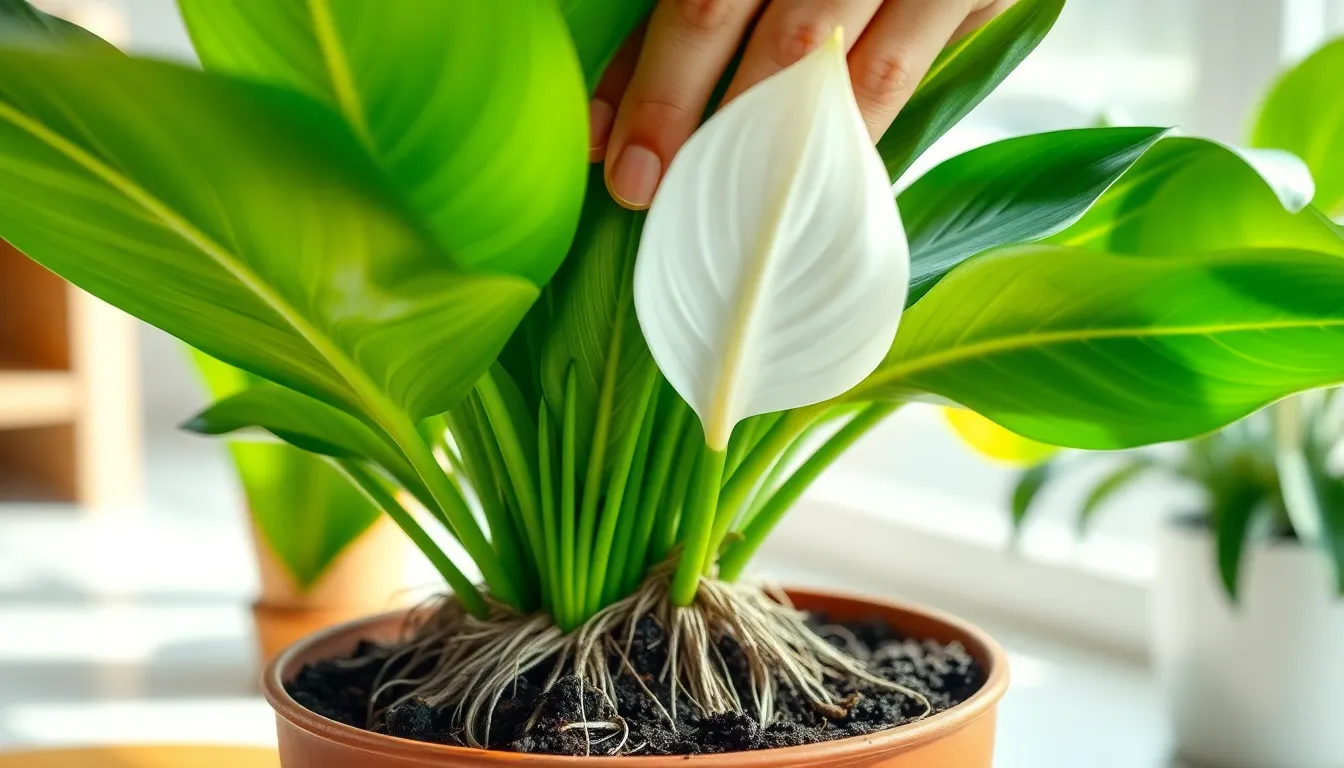
Repotting revitalizes peace lilies by providing fresh nutrients and adequate root space for continued growth. This essential maintenance practice extends their 3 to 5 year typical lifespan significantly when performed correctly.
Signs Your Peace Lily Needs Repotting
Roots appearing above the soil surface indicate the plant has outgrown its current container. Drainage holes filled with emerging roots signal overcrowding that restricts healthy development.
Soil depletion becomes evident when previously thriving plants show reduced vigor even though proper care. Nutrient-depleted growing medium cannot sustain optimal peace lily health regardless of fertilization efforts.
Visible decline manifests through yellowing leaves and decreased blooming frequency. Stress symptoms like wilting even though adequate moisture often stem from root-bound conditions requiring immediate repotting attention.
Water drains too quickly through the pot when roots occupy most of the soil space. Conversely, water retention increases when compacted roots prevent proper drainage flow.
Step-by-Step Repotting Process
Choose a container only 1 to 2 inches larger in diameter than the current pot. Oversized containers retain excess moisture that promotes root rot in peace lilies.
Prepare well-draining potting mix using equal parts peat moss, perlite, and high-quality potting soil. Commercial African violet mixes work effectively for peace lily repotting projects.
Remove the plant gently by turning the pot sideways and sliding the root ball out intact. Stubborn plants may require gentle pot tapping to loosen compacted soil.
Examine root systems for circling patterns that indicate binding. Trim any brown, mushy, or excessively long roots using clean pruning shears to encourage fresh growth.
Position the plant in the new container at the same soil depth as previously grown. Center the root ball and fill around edges with fresh potting mixture.
Water thoroughly until excess moisture drains from the bottom holes. Initial watering settles the soil and eliminates air pockets around transplanted roots.
Monitor for transplant shock during the first 2 weeks by watching for temporary wilting or leaf drooping. Normal recovery occurs within 7 to 14 days with proper post-repotting care.
Preventing Common Diseases and Pests
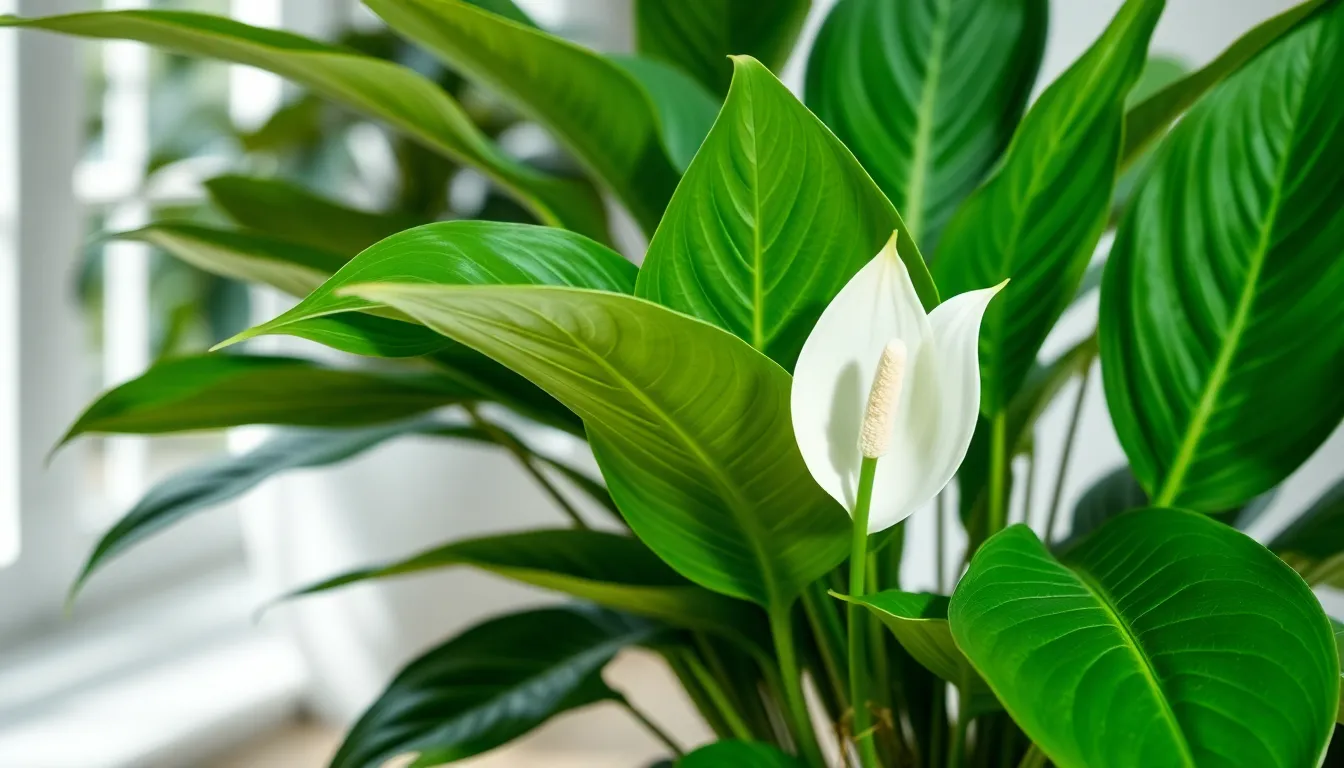
Disease prevention and pest management significantly extend peace lily lifespans beyond the typical 3 to 5 years. Proactive monitoring and swift intervention protect these plants from common threats that can dramatically shorten their lives.
Early Detection Methods
Leaf condition monitoring serves as the primary indicator of peace lily health problems. Yellowing leaves often signal overwatering issues, while browning leaf edges indicate dry conditions or pest activity. We examine leaves weekly for color changes, spots, or unusual markings that suggest developing problems.
Root health inspection during annual repotting reveals critical information about plant condition. Healthy roots appear white or cream-colored, while black or mushy roots indicate rot from excessive moisture. We gently remove plants from containers to check root systems when growth slows or leaves show distress signs.
Pest infestation detection requires careful observation of leaf surfaces and stems. Spider mites create fine webs on leaf undersides, while mealybugs appear as white cotton-like spots on stems and leaf joints. We use magnifying glasses to spot tiny pests before infestations spread throughout the plant.
Treatment and Prevention Strategies
Water management practices prevent the most common peace lily problems. We water only when the top inch of soil feels dry to the touch, avoiding both overwatering and underwatering stress. Bottom watering methods reduce leaf moisture that encourages fungal growth and pest problems.
Humidity maintenance creates unfavorable conditions for spider mites while supporting plant health. We maintain humidity levels above 50% using humidifiers or humidity trays to prevent leaf browning and pest establishment. Misting provides temporary humidity increases but requires careful timing to avoid fungal issues.
Regular pruning schedules remove potential disease sources and stressed plant material. We cut yellowing or browning leaves at soil level using clean pruning shears to prevent pathogen spread. Dead flowers also get removed promptly to redirect plant energy toward healthy growth.
Annual repotting protocols refresh growing medium and eliminate accumulated soil pathogens. We inspect roots thoroughly during repotting, removing any rotted sections with sterile tools. Fresh potting soil provides disease-free growing conditions and improved drainage.
Fertilization timing supports plant immunity without encouraging pest problems. We apply diluted liquid fertilizer during the growing season only, avoiding overfeeding that creates tender growth attractive to insects. Balanced fertilizers at half-strength concentrations provide adequate nutrition without stressing plants.
Seasonal Care Adjustments
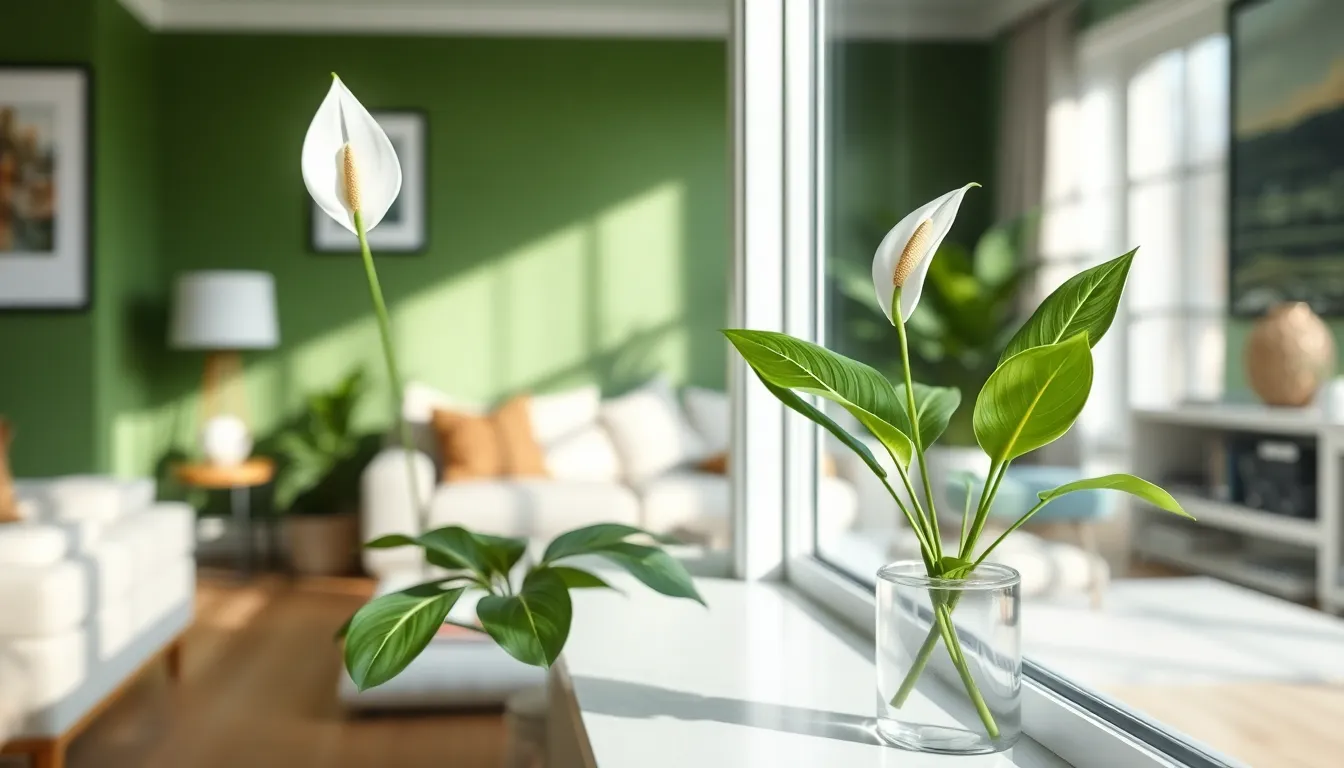
Peace lilies require different care approaches throughout the year to maximize their 5 to 10 year indoor lifespan. Adapting our maintenance routine to match seasonal growth patterns keeps these tropical plants thriving year-round.
Winter Care Requirements
Reduce watering frequency to when only the top inch of soil feels dry during winter months. The plant’s metabolism slows significantly in cooler temperatures, requiring less water than during active growing periods.
Eliminate fertilization completely from October through February. Peace lilies enter a natural dormancy phase where feeding can actually harm root systems and cause nutrient buildup in soil.
Maintain temperatures above 65°F (18°C) consistently throughout winter. Cold drafts from windows, doors, or heating vents stress peace lilies and can reduce their overall lifespan by 2 to 3 years.
Increase humidity levels using misting, pebble trays, or room humidifiers. Indoor heating systems drop humidity below the 40% minimum that peace lilies require for healthy foliage.
Position plants away from direct heat sources like radiators, fireplaces, or heating vents. These create rapid temperature fluctuations that shock peace lily root systems.
Provide consistent indirect sunlight through south or east-facing windows. Winter light levels naturally decrease, making bright indirect exposure more critical for photosynthesis.
Summer Growing Season Tips
Water more frequently to keep soil consistently moist but never waterlogged during spring and summer months. Active growth periods require 2 to 3 times more water than winter dormancy.
Apply balanced liquid fertilizer every 1 to 2 weeks from March through September. Dilute fertilizer to half strength to prevent root burn while supporting vigorous growth.
Repot annually in fresh soil during spring months when root systems are actively expanding. Crowded roots reduce nutrient uptake and can shorten peace lily lifespans by several years.
Enhance humidity through regular misting or relocating plants to naturally humid rooms like bathrooms or kitchens. Summer air conditioning systems often drop humidity below optimal levels.
Clean leaves weekly with damp cloths to remove dust accumulation. Clean foliage improves photosynthesis efficiency and prevents pest infestations that stress plants.
Monitor light exposure carefully during summer months. Bright indirect light promotes blooming, but direct sunlight burns leaves and weakens overall plant health.
Signs of Aging and Natural Decline
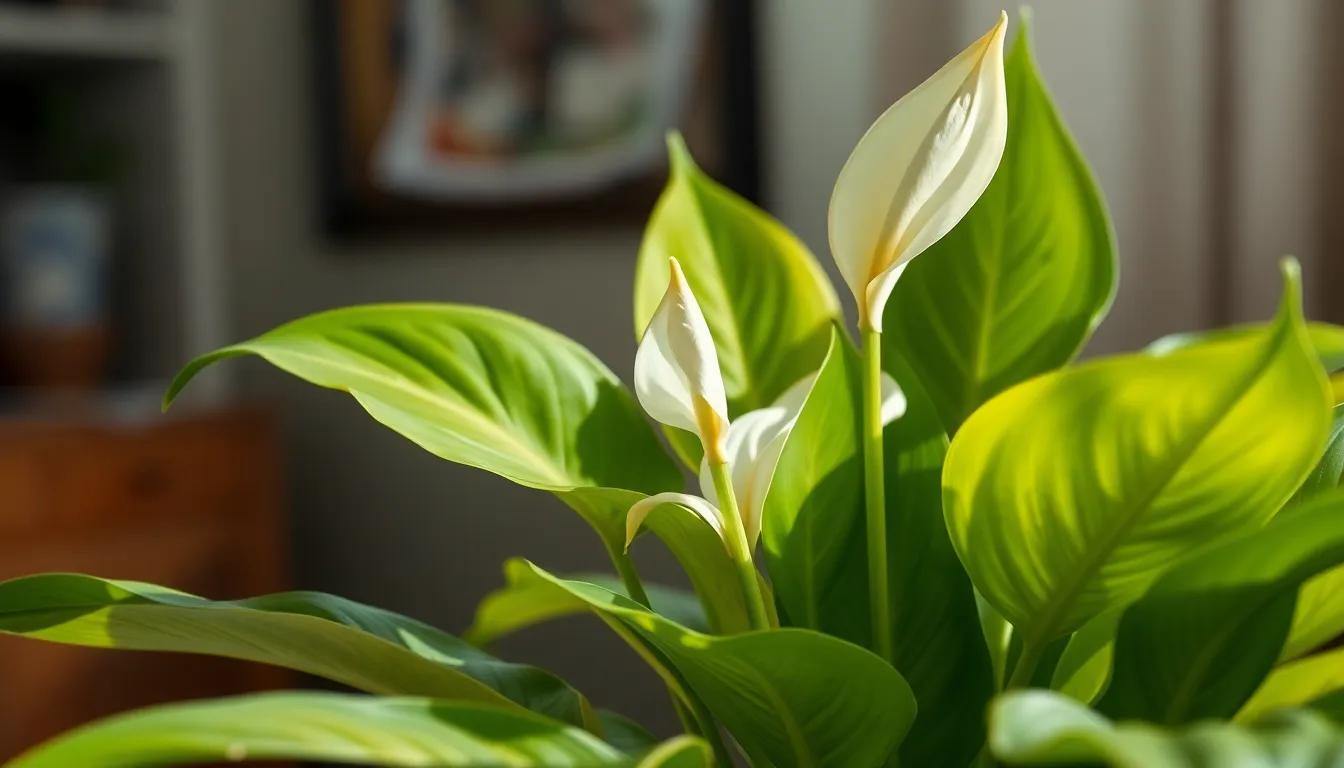
Even with excellent care, peace lilies show visible signs of aging as they approach their 3 to 5 year average lifespan. Recognizing these natural decline indicators helps us distinguish between normal aging and care issues.
Yellowing leaves appear first as the plant redirects energy from older foliage to new growth. Lower leaves typically yellow before upper ones, creating a natural pruning pattern that conserves plant resources.
Reduced blooming frequency becomes evident when flowers appear less often or stop entirely. Peace lilies in their prime bloom every 2 to 3 months, but aging plants may bloom only once or twice per year.
Weakening stem structure develops as once-sturdy petioles become brittle and bend easily. Stems that previously supported large leaves now struggle with smaller foliage loads.
Increased disease susceptibility occurs when the plant’s natural defenses weaken. Fungal infections, pest infestations, and bacterial issues affect aging peace lilies more frequently than younger specimens.
Recognizing End-of-Life Indicators
Persistent wilting signals severe decline when leaves remain droopy even though proper watering and humidity. Plants showing this symptom for more than 2 weeks rarely recover fully.
Extensive root rot becomes visible during repotting as black, mushy roots that smell sour. Peace lilies with more than 50% damaged roots typically cannot regenerate healthy root systems.
Complete bloom cessation for periods exceeding 6 months indicates declining plant vigor. Healthy peace lilies maintain some flowering capability even during dormant seasons.
Widespread pest colonization occurs when aphids, spider mites, or scale insects establish large populations even though treatment attempts. Severely weakened plants cannot resist persistent infestations.
When to Consider Replacement
Replace peace lilies when multiple decline indicators persist for 3 to 4 months even though optimal care adjustments. Plants showing persistent wilting, extensive root damage, and complete bloom cessation rarely return to full health.
Consider replacement when pest control efforts fail after 2 to 3 treatment cycles using organic pesticides. Heavily infested plants often suffer irreversible stress that shortens their remaining lifespan.
Age-related replacement becomes necessary when peace lilies exceed 5 to 7 years and show declining vigor. Older plants require increasingly intensive care while producing fewer blooms and smaller foliage.
Division opportunities present natural replacement timing when rootbound plants produce healthy offshoots. Separating vigorous divisions from declining parent plants ensures continued peace lily presence in our indoor spaces.
Troubleshooting Common Lifespan Issues
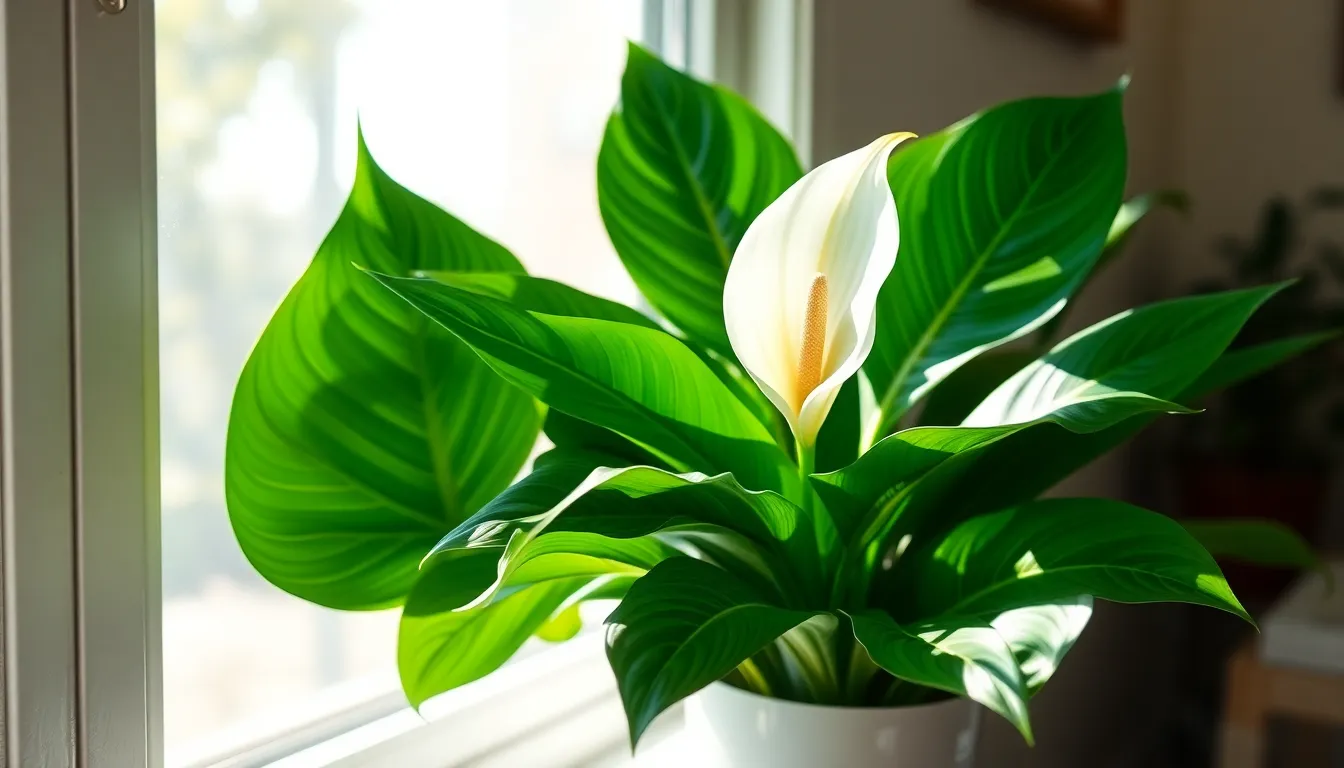
Peace lilies experiencing declining health often display exact symptoms that indicate underlying care issues. Addressing these problems early helps extend your plant’s lifespan beyond the typical 3 to 5 years.
Premature Yellowing Problems
Overwatering causes the most frequent yellowing issues in peace lilies, creating waterlogged soil conditions that damage root systems. Yellowing leaves typically appear first on lower sections of the plant when roots cannot absorb oxygen properly. We recommend checking soil moisture levels by inserting your finger 1 to 2 inches deep before watering.
Underwatering produces similar yellowing symptoms but affects leaves throughout the entire plant simultaneously. Peace lilies display drooping foliage alongside yellow coloration when water stress occurs. Monitor your watering schedule to maintain consistent soil moisture without creating soggy conditions.
Direct sunlight exposure accelerates leaf yellowing by scorching delicate peace lily foliage. These plants thrive in bright, indirect light conditions that mimic their native tropical understory habitat. Relocate your peace lily 3 to 6 feet away from windows that receive direct morning or afternoon sun.
Stunted Growth Answers
Poor soil quality restricts nutrient uptake and limits peace lily growth potential significantly. Compact or depleted potting mixes prevent proper root development and water drainage. Replace existing soil with fresh, well-draining potting mix containing organic matter like peat moss or coconut coir.
Inadequate light conditions slow photosynthesis and reduce energy production for new growth. Peace lilies require bright, filtered light equivalent to 200 to 400 foot-candles for optimal development. Position your plant near north-facing windows or use sheer curtains to filter harsh southern exposure.
Insufficient fertilization depletes essential nutrients needed for healthy leaf and flower production. Apply balanced liquid fertilizer diluted to half strength every 4 to 6 weeks during growing season (spring through early fall). Avoid fertilizing during winter months when peace lilies enter natural dormancy periods.
Revival Techniques for Struggling Plants
Repotting revitalizes declining peace lilies by providing fresh growing medium and additional root space. Remove your plant from its current container and examine roots for signs of rot or binding. Trim away damaged root sections using clean pruning shears before transplanting into a container 1 to 2 inches larger in diameter.
Pruning removes energy-draining damaged foliage and redirects plant resources toward new growth development. Cut yellowing or brown leaves at their base using sterilized pruning tools to prevent disease transmission. Remove spent flower stalks immediately after blooming to encourage future flower production.
Environmental adjustments restore optimal growing conditions for stressed peace lilies experiencing declining health. Maintain temperatures between 65°F to 80°F consistently throughout the year to prevent temperature shock. Increase humidity levels to 40 to 60 percent using humidifiers, pebble trays, or grouping plants together to create beneficial microclimates.
Propagation to Extend Your Plant Family
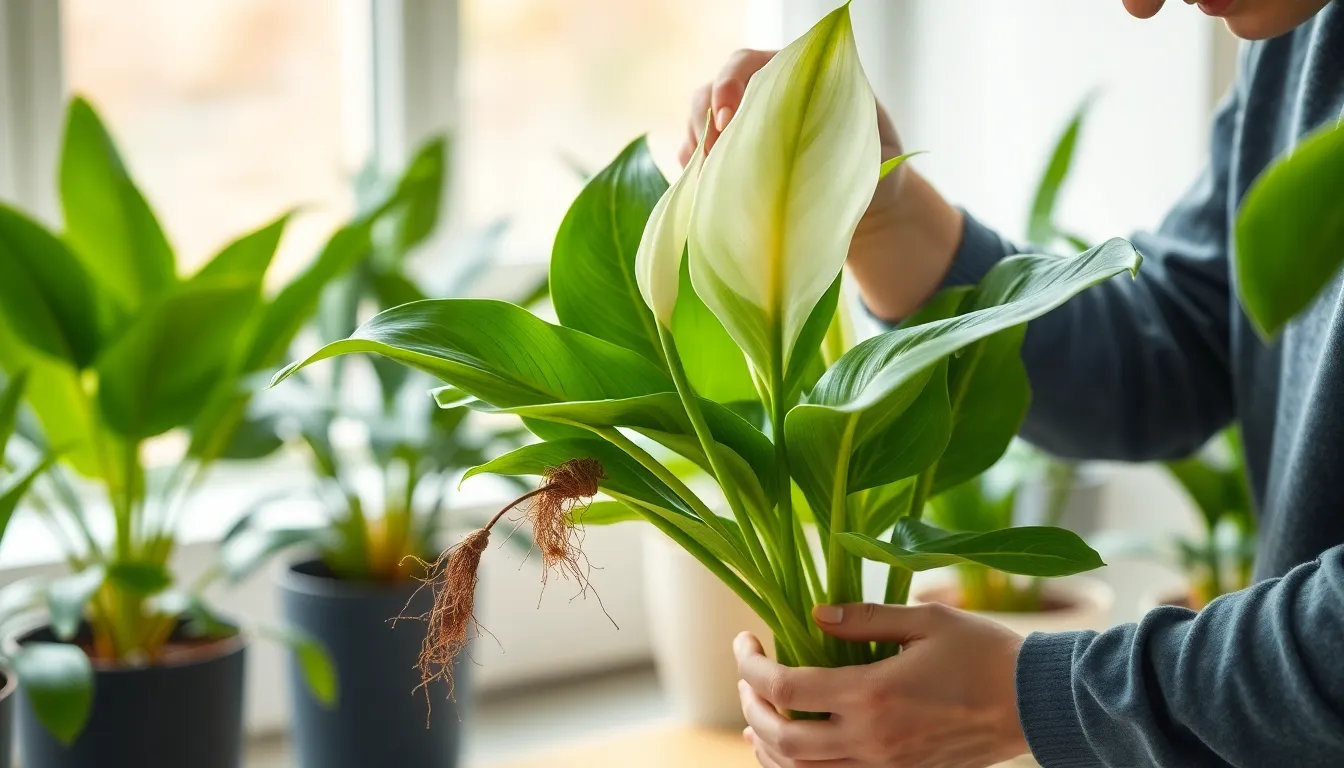
Propagation through division creates multiple peace lilies from a single mature plant, effectively extending both the plant family and the original plant’s productive lifespan. Division rejuvenates aging peace lilies while producing healthy new plants that can live 3 to 5 years or longer with proper care.
Division Method for New Plants
Select mature plants that are at least 3 years old with multiple visible stems emerging from the soil. These established peace lilies possess the root development necessary for successful division.
Prepare the plant by watering thoroughly 24 hours before division. Moist soil separates more easily from roots and reduces transplant shock during the process.
Remove the entire plant from its container by gently inverting the pot and supporting the root ball. Shake away excess soil to expose the root structure and identify natural separation points.
Divide the root system using clean pruning shears or a sharp knife to separate sections. Each new division requires at least one growing stem with attached healthy roots measuring 2 to 3 inches in length.
Replant divisions immediately in well-draining potting soil mixed with organic matter. Choose containers that are 1 to 2 inches larger than each division’s root system to allow growth without overwhelming the young plant.
Caring for Young Divisions
Lighting requirements for new divisions include bright, indirect light positioned 3 to 6 feet from windows. Direct sunlight burns delicate new growth while insufficient light slows establishment.
Watering frequency increases during the first 4 to 6 weeks as divisions establish new root systems. Check soil moisture daily and water when the top inch feels dry to the touch.
Temperature stability between 65°F and 80°F promotes fastest root development in young divisions. Avoid temperature fluctuations greater than 10°F during the establishment period.
Humidity levels above 50% support healthy leaf development and reduce transplant stress. Place humidity trays filled with water and pebbles beneath pots or group divisions together to increase ambient moisture.
Conclusion
We’ve explored the comprehensive care strategies that can help your peace lily thrive for 5 to 10 years or even longer indoors. With proper attention to watering techniques humidity levels lighting conditions and regular maintenance these elegant plants can become long-term companions in your home.
Remember that extending your peace lily’s lifespan isn’t just about following a checklist—it’s about understanding your plant’s unique needs and responding to seasonal changes. Through division and propagation you can create new plants while revitalizing older ones ensuring your peace lily family continues to flourish.
The key to maximizing your peace lily’s longevity lies in consistent care early problem detection and creating an environment that mimics their natural tropical habitat. With these practices you’ll enjoy their stunning blooms and air-purifying benefits for years to come.
Frequently Asked Questions
How long do peace lilies live indoors?
Peace lilies typically live 5 to 10 years indoors with proper care. Some exceptional plants can last even longer when their specific needs are met consistently. Outdoor peace lilies in tropical climates can survive 15 to 20 years or more due to optimal growing conditions.
What factors affect a peace lily’s lifespan?
Key factors include light exposure, watering consistency, humidity levels, temperature stability, fertilization frequency, and repotting timing. Maintaining bright indirect light, consistent temperatures between 65°F to 80°F, high humidity, and proper watering significantly extends their lifespan.
How often should I repot my peace lily?
Repot peace lilies annually or every 1 to 2 years when they become rootbound. Signs include roots appearing above soil surface, drainage holes filled with roots, and visible decline in plant health. Proper repotting can extend their typical 3 to 5-year lifespan.
What are the signs of an aging peace lily?
Common signs include yellowing leaves, reduced blooming frequency, weakening stems, and increased disease susceptibility. End-of-life indicators include persistent wilting despite proper care, extensive root rot, and widespread pest colonization that doesn’t respond to treatment.
How should I water my peace lily for maximum lifespan?
Use bottom watering to prevent leaf moisture issues. Allow the top inch of soil to dry out before watering again. Consistent watering prevents both overwatering (which causes root rot) and underwatering (which stresses the plant and shortens lifespan).
When should I fertilize my peace lily?
Apply water-soluble balanced fertilizer at half-strength during the growing season (spring and summer). Avoid fertilizing during winter dormancy as this can stress the plant. Proper fertilization timing supports plant immunity without attracting pests.
Can I propagate my peace lily to extend its life?
Yes, division is an excellent way to create new plants from mature peace lilies. This method extends both your plant family and the original plant’s productive lifespan. Divide rootbound plants every 1 to 2 years for best results.
What seasonal care adjustments do peace lilies need?
In winter, reduce watering, eliminate fertilization, maintain temperatures above 65°F, and increase humidity. During summer, water more frequently, apply balanced fertilizer monthly, consider annual repotting, and enhance humidity levels for optimal growth.
When should I replace my peace lily?
Consider replacement when multiple decline indicators persist despite optimal care, after failed pest control efforts, or when plants exceed 5 to 7 years and show declining vigor. Division opportunities also provide natural replacement timing.
How do I prevent diseases and pests in peace lilies?
Practice early detection by monitoring leaf conditions and inspecting roots during repotting. Maintain proper watering, humidity levels, regular pruning, and annual repotting. Avoid over-fertilization and ensure good air circulation around the plant.

